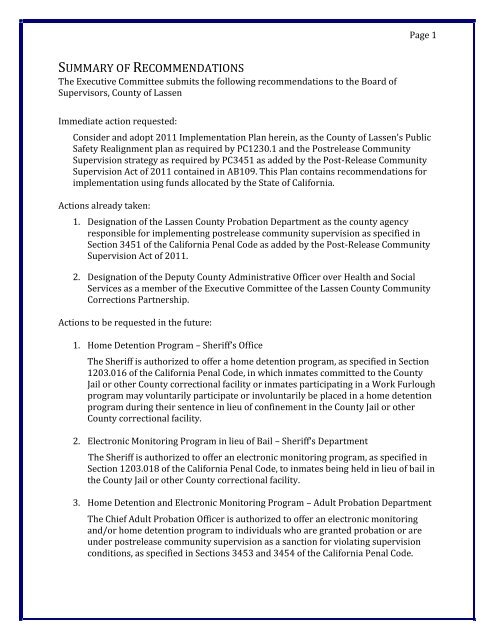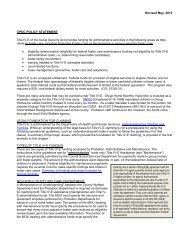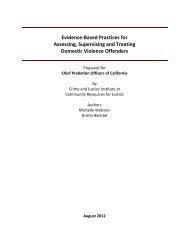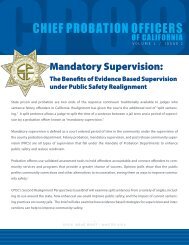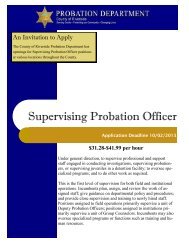Lassen County - Chief Probation Officers of California
Lassen County - Chief Probation Officers of California
Lassen County - Chief Probation Officers of California
You also want an ePaper? Increase the reach of your titles
YUMPU automatically turns print PDFs into web optimized ePapers that Google loves.
Page 2OVERVIEW OF 2011 PUBLIC SAFETY REALIGNMENT ACT (AB109)In an effort to address overcrowding in <strong>California</strong>’s prisons and assist in alleviatingthe state’s financial crisis, the Public Safety Realignment Act (Assembly Bill 109)was signed into law on April 4, 2011. AB109 transfers responsibility for supervisingspecified lower level inmates and parolees from the <strong>California</strong> Department <strong>of</strong>Corrections and Rehabilitation to counties. Implementation <strong>of</strong> the Public SafetyRealignment Act is scheduled for October 1, 2011.Additionally, Section 1230 <strong>of</strong> the <strong>California</strong> Penal Code is amended to read “Eachcounty local Community Corrections Partnership established pursuant tosubdivision (b) <strong>of</strong> Section 1230 shall recommend a local plan to the <strong>County</strong> Board <strong>of</strong>Supervisors for the implementation <strong>of</strong> the 2011 public safety realignment. (b) Theplan shall be voted on by an executive committee <strong>of</strong> each county’s CommunityCorrections Partnership consisting <strong>of</strong> the <strong>Chief</strong> <strong>Probation</strong> Officer <strong>of</strong> the county aschair, a <strong>Chief</strong> <strong>of</strong> Police, the Sheriff, the District Attorney, the Public Defender,presiding Judge or his or her designee, and the department representative listed ineither section 1230 (b) (2) (G), 1230 (b) (2) (H), or 1230 (b) (2) (J) as designated bythe county board <strong>of</strong> supervisors for purposes related to the development andpresentation <strong>of</strong> the plan. (c) The plan shall be deemed accepted by the <strong>County</strong> Board<strong>of</strong> Supervisors unless rejected by a vote <strong>of</strong> 4/5ths in which case the plan goes backto the Community Corrections Partnership for further consideration. (d) Consistentwith local needs and resources, the plan may include recommendations to maximizethe effective investment <strong>of</strong> criminal justice resources in evidence-based correctionalsanctions and programs, including, but not limited to, day reporting centers, drugcourts, residential multiservice centers, mental health treatment programs,electronic and GPS monitoring programs, victim restitution programs, counselingprograms, community service programs, educational programs, and work trainingprograms.”Key elements <strong>of</strong> AB109 include:Target Population: The postrelease community supervision population, releasedfrom prison to community supervision, is the responsibility <strong>of</strong> local probationdepartments and is inclusive <strong>of</strong> non-violent, non-serious, non-sex <strong>of</strong>fenders with aprior PC 667.5(c), PC 1192.7(c) or registerable <strong>of</strong>fenses pursuant to Penal Codesection 290. The population that will serve their prison sentences locally includesthe non-violent, non-serious, non-sex <strong>of</strong>fender group. The <strong>California</strong> Department <strong>of</strong>Correction and Rehabilitation (CDCR) estimates <strong>Lassen</strong> <strong>County</strong>’s “average dailypopulation” (ADP) <strong>of</strong> these <strong>of</strong>fenders will be:26 Postrelease community supervision6 Parole and postrelease community supervision violators in jail onrevocations32 Sentenced to local incarceration under AB109
Page 3At some point in time all 64 (rounding up to 70 during Fiscal Year 2011-12) <strong>of</strong>fenders willbe on postrelease community supervision to Adult <strong>Probation</strong>, requiring the full range <strong>of</strong>supervision, sanctions, and service resources available through the department.This population becomes a local responsibility as <strong>of</strong> October 1, 2011 when the Post-ReleaseCommunity Supervision Act <strong>of</strong> 2011 is implemented. These estimates are based upondata provided by CDCR using Department <strong>of</strong> Finance estimates; however, theCommunity Corrections Partnership Executive Committee anticipates the actualpopulation to be greater than the State projections.Additional key elements <strong>of</strong> AB109 include: Redefining Felonies: Revises the definition <strong>of</strong> a felony to include certain crimes thatare punishable in jail for 16 months, 2 years, or 3 years. Some <strong>of</strong>fenses, includingserious, violent and sex-<strong>of</strong>fenses, are excluded and sentences will continue to beserved in state prison. Local Postrelease Community Supervision: Offenders released from state prison onor after October 1, 2011 after serving a sentence for an eligible <strong>of</strong>fense shall besubject to, for a period not to exceed 3 years, postrelease community supervisionprovided by a county agency designated by that county’s Board <strong>of</strong> Supervisors. Revocations Heard & Served Locally: Postrelease community supervision and parolerevocations will be served in local jails (by law maximum revocation sentence is upto 180 days), with the exception <strong>of</strong> paroled ‘lifers’ who have a revocation term <strong>of</strong>greater than 30 days. The Courts will hear final revocation hearings while the Board<strong>of</strong> Parole Hearings will conduct parole violation hearings in jail. Changes to Custody Credits: Jail inmates will be able to earn four days <strong>of</strong> credit forevery two days served. Time spent on home detention (i.e., electronic monitoring) iscredited as time spent in jail custody. Alternative Custody: Penal Code Section 1203.018 authorizes electronic monitoringfor inmates being held in the county jail in lieu <strong>of</strong> bail. Eligible inmates must first beheld in custody for 60 days post-arraignment, or 30 days for those charged withmisdemeanor <strong>of</strong>fenses. Community-Based Punishment: Authorizes counties to use a range <strong>of</strong> communitybasedpunishment and intermediate sanctions other than jail incarceration alone ortraditional routine probation supervision.
Page 4LOCAL PLANNING AND OVERSIGHTCOMMUNITY CORRECTIONS PARTNERSHIPIn the last two years, there have been statewide efforts to expand the use <strong>of</strong> evidence basedpractices in sentencing and probation practices, and to reduce the state prison population.SB 678 (2009) established a Community Corrections Partnership (CCP) in each county,chaired by the <strong>Chief</strong> <strong>Probation</strong> Officer, charged with advising on the implementation <strong>of</strong> SB678 funded initiatives. AB109 (2011) established an Executive Committee <strong>of</strong> the CCPcharged with development <strong>of</strong> a 2011 Realignment Plan that will recommend a county wideprogramming plan for the realigned population, for consideration and adoption by theBoard <strong>of</strong> Supervisors.The CCP Executive Committee will advise on the progress <strong>of</strong> the Implementation Plan.Chaired by the <strong>Chief</strong> <strong>Probation</strong> Officer, the CCP Executive Committee will oversee therealignment process and advise the Board <strong>of</strong> Supervisors in determining funding andprogramming for the various components <strong>of</strong> the plan. Voting members <strong>of</strong> the ExecutiveCommittee include: a Judge (appointed by the Presiding Judge); <strong>Chief</strong> <strong>Probation</strong> Officer;<strong>County</strong> Sheriff; District Attorney; <strong>Chief</strong> <strong>of</strong> Police; Public Defender; and Director <strong>of</strong> <strong>County</strong>Social Services/Mental/Public Health (as determined by the Board <strong>of</strong> Supervisors).This plan was developed by CCP Executive Committee members, their designees and otherkey partners. Meeting attendees included:Julie MorganLetha MartinTracy StewartJeanette GoniJim ChapmanBob BurnsDenise StelzerKevin MannelMelody BrawleyKen CrandellAnita HarshSusan HawkinsJoanna ZimmermanRich DuvarneyDarla DwinellColette Helwig<strong>Lassen</strong> <strong>County</strong> Administration<strong>Lassen</strong> <strong>County</strong> <strong>Probation</strong><strong>Lassen</strong> <strong>County</strong> <strong>Probation</strong><strong>Lassen</strong> <strong>County</strong> <strong>Probation</strong><strong>Lassen</strong> <strong>County</strong> Board <strong>of</strong> Supervisors<strong>Lassen</strong> <strong>County</strong> District Attorney’s Office<strong>Lassen</strong> <strong>County</strong> District Attorney’s Office<strong>Lassen</strong> <strong>County</strong> Health & Social Services<strong>Lassen</strong> <strong>County</strong> Health & Social Services (Community SocialServices)<strong>Lassen</strong> <strong>County</strong> Health & Social Services (Mental Health)<strong>Lassen</strong> <strong>County</strong> Health & Social Services (Alcohol & Drug)<strong>Lassen</strong> <strong>County</strong> Health & Social Services (Veteran’s Services)<strong>Lassen</strong> <strong>County</strong> Health & Social Services (Public Health)<strong>Lassen</strong> <strong>County</strong> Office <strong>of</strong> Education<strong>Lassen</strong> Family Services<strong>Lassen</strong> Family Services
Page 5Michelle RigneyMaria Carlomagno-BriceJeff AtkinsonTom DowningRhea GiannottiDean GrowdonCurt GatieMatthew McFarlandJohn Mineau<strong>Lassen</strong> Family ServicesChild Support ServicesCity <strong>of</strong> Susanville Police DepartmentCity <strong>of</strong> Susanville Police Department<strong>Lassen</strong> <strong>County</strong> Public Defender<strong>Lassen</strong> <strong>County</strong> Sheriff’s Department<strong>Lassen</strong> <strong>County</strong> Sheriff’s Department<strong>Lassen</strong> <strong>County</strong> Sheriff’s Department<strong>Lassen</strong> <strong>County</strong> Sheriff’s DepartmentHonorable F. Donald Sokol <strong>Lassen</strong> <strong>County</strong> Superior CourtRosemari Reed<strong>Lassen</strong> <strong>County</strong> Superior CourtNancy Holsey<strong>Lassen</strong> <strong>County</strong> Superior Court
Page 6NEW POPULATIONS AND FUNDINGPROJECTED POPULATIONThe State has estimated <strong>Lassen</strong> <strong>County</strong> will assume responsibility for approximately 70additional <strong>of</strong>fenders at any point in time across all agencies. This population is diverse andincludes <strong>of</strong>fenders who have been convicted <strong>of</strong> property, public order, drug, and domesticviolence <strong>of</strong>fenses, and possible gang-involved <strong>of</strong>fenders. Of these estimated 70 people, it isanticipated that at any one time an average daily population <strong>of</strong> approximately 40 <strong>of</strong>fenderswill be serving a sentence <strong>of</strong> local incarceration or sanctioned to othercustodial/programmatic options. All estimated 70 people will at some point be onpostrelease community supervision. 1PROJECTED FUNDINGThe formula establishing statewide funding allotments for AB109 implementation in FiscalYear (FY) 2011-12 assumes $25,000 per <strong>of</strong>fender for six months <strong>of</strong> local incarceration, witheach <strong>of</strong> these <strong>of</strong>fenders allocated $2,275 for rehabilitative services while incarcerated or inalternative incarceration programs. This same level <strong>of</strong> funding will be made available forparole violators serving a 60-day revocation, albeit on a pro-rated basis. Offenders onpostrelease community supervision are funded at $3,500 per person for communitysupervision and $2,275 per person for rehabilitative services (for a maximum <strong>of</strong> 18months). The above formula establishing a statewide allotment was developed by the StateDepartment <strong>of</strong> Finance and agreed to by <strong>County</strong> Administrative <strong>Officers</strong> (CAO) and<strong>California</strong> State Association <strong>of</strong> Counties (CSAC).The level <strong>of</strong> local funding available through AB109 is based on a weighted formulacontaining three elements: 60% based on estimated average daily population (ADP) <strong>of</strong> <strong>of</strong>fenders meetingAB109 eligibility criteria 30% based on U.S. Census Data pertaining to the total population <strong>of</strong> adults (18-64)in the <strong>County</strong> as a percentage <strong>of</strong> the statewide population; and 10% based on the SB 678 distribution formulaBased on this formula <strong>Lassen</strong> <strong>County</strong> is projected to receive $525,712 for FY 2011-12 toserve approximately 70 additional <strong>of</strong>fenders at any point in time. This funding includes:Postrelease Community Supervision (PRCS)/local incarceration $384,770AB109 Planning grant $100,000AB109 Training and implementation activities $ 27,150District Attorney/Public Defender (PCS representation) $ 13,792TOTAL $525,7121 These estimates are based upon data provided by CDCR; however, the Community CorrectionsPartnership Executive Committee anticipates the actual population to be greater than the Stateprojections.
Page 7Funding for <strong>Lassen</strong> <strong>County</strong> Superior Court operations is unknown at this time; theAdministrative Office <strong>of</strong> the Courts (AOC) will make this determination <strong>of</strong> the fundingdistribution in the near future.The funding formula is based on an October 1, 2011 implementation through June 30, 2012and is for the first year only. CSAC/CAO’s and the Department <strong>of</strong> Finance will revisit theformula for future years.
Page 8PROPOSED IMPLEMENTATION STRATEGIESThe proposed strategies that follow take into consideration the multifaceted needs <strong>of</strong> theAB109 population, and the resources necessary to achieve desired public safety outcomes.I. SHERIFF’S OFFICE – COUNTY JAIL INMATESPROJECTED ADDITIONAL NUMBER OF INMATESThe Sheriff’s Office (LCSO) will see a steady increase in inmate population due to publicsafety realignment. The projections provided by CDCR estimate an average dailypopulation increase <strong>of</strong> 38 at full implementation. The additional inmates include (1) thoseconvicted <strong>of</strong> a felony now sentenced to 16 months, 2 years, or 3 years in county jail in lieu<strong>of</strong> state prison; (2) violators <strong>of</strong> postrelease community supervision; (3) violators <strong>of</strong> stateparole up to 180 days (an exception is that paroled lifers with revocation terms greaterthan 30 days will serve time in state prison); and (4) postrelease community superviseessanctioned with flash incarceration <strong>of</strong> up to 10 days for each violation.The most significant immediate impact will be the violators <strong>of</strong> state parole who will nowremain in the custody <strong>of</strong> LCSO for up to 180 days. CDCR is counting on this shift to cause areduction in their inmate population. The reduction in CDCR population will cause anincrease in county jail populations. The impacts to LCSO related to these <strong>of</strong>fenders areestimated to be an increased average daily population <strong>of</strong> 6. These <strong>of</strong>fenders have failed toprogram under the supervision <strong>of</strong> State Parole, are less likely to comply with programrequirements in the jail, and will increase the risk <strong>of</strong> assault on jail personnel, and otherinmates.The estimates listed above are based on data provided by CDCR; however, LCSO anticipatesthe actual population increase to be greater than the State projections. The state’spopulation projections are based on average daily population (ADP) along with someassumptions from the department <strong>of</strong> finance. The ADP is calculated based upon one inmatein one bed for an entire year. ADP does not account for “surge” population. ADP is basedon the equilibrium that is reached once a population stabilizes and new bookings balanceout against releases. Historically, CDCR experiences intake surges in the months <strong>of</strong> August,October, March and June. Intake peaks in these months and drops to its lowest numbers inNovember and February. It is the balance <strong>of</strong> the high months and lows that combine for theADP, but during periods <strong>of</strong> peak intake, our surge capacity will exceed the 38 beds thatCDCR is projecting at Full Implementation. The newest CDCR data expect that <strong>Lassen</strong><strong>County</strong> will average 3 new felony commitments each month for the next two years and onenew parole violator per month. Those four inmates per month will cause us to gain 48 newinmates this first year alone. The length <strong>of</strong> sentence will vary, but ultimately theconfinement period will dictate the true population increase. The state ADP projections arealso based on the department <strong>of</strong> finance assumption that <strong>of</strong>fenders sentenced to less than 3years will only serve 6 months in custody. Considering the felonies in question are eligiblefor a sentence <strong>of</strong> 16 months (minimum), 2 years (mid-term), or 3 years (upper term); if an<strong>of</strong>fender received maximum credit reductions for good conduct / work credits, the
Page 9sentences would reduce to 8 months, 1 year, or 18 months respectively. Department <strong>of</strong>Finance is relying heavily on alternative sentencing for felony <strong>of</strong>fenders to reach the lowestimate <strong>of</strong> 6 months in custody on a felony <strong>of</strong>fense. Additionally, for those <strong>of</strong>fenderssentenced to more than 3 years, department <strong>of</strong> finance estimates an average length <strong>of</strong> stayat 24 months. Again, this could prove a dangerous assumption relying on alternatives tophysical custody. The primary purposes <strong>of</strong> realignment are to reduce overcrowding (inprisons) cut costs (for state prisons) and reduce recidivism. Therefore, if these estimatesare incorrect, local government should presume that the state will have made the error in adirection most favorable to the state; not to local governments.It is also noteworthy to consider; the state is making “alternative to custody” assumptionsfor population management on felony <strong>of</strong>fenders now committed to county jails.Historically, these alternatives have not been available as population controls for felonyprison inmates. The legislature made these alternatives available, while at the same timetransferring these <strong>of</strong>fenders to local custody. These, never before available options arenow the responsibility <strong>of</strong> local <strong>of</strong>ficials. Sheriffs’ personnel will have to consider potentialrelease options on felony <strong>of</strong>fenders that have not been tried in the past. The stateeffectively crafted a pilot project to release felons back into our communities but placedlocal <strong>of</strong>ficials in a position to bear the burden if this experiment fails.The Sheriff wants to try to implement the provisions <strong>of</strong> AB109 as intended by thelegislature, but his primary responsibility will be to maintain the security <strong>of</strong> ourcommunities.PROJECTED IMPACTS ON CUSTODY PROGRAMSThe impacts <strong>of</strong> population increases from realignment will impact all inmates in thecustody <strong>of</strong> the Sheriff, and every program in the <strong>County</strong> Jail. The Sheriff has manyconsiderations related to the housing <strong>of</strong> inmates in custody. Many people consider overalljail bed space one <strong>of</strong> the most pressing issues facing local jails. In <strong>Lassen</strong> <strong>County</strong>, the jailcurrently has more than adequate bed space to deal with the total number <strong>of</strong> projectedinmates. However, the bigger issue is the lack <strong>of</strong> segregated housing space available.Pursuant to Penal Code Section 4002: “Persons committed on criminal process and detainedfor trial, persons convicted and under sentence, and persons committed upon civil process,shall not be kept or put in the same room, nor shall male and female prisoners, excepthusband and wife, sleep, dress or undress, bathe, or perform eliminatory functions in the sameroom. However, persons committed on criminal process and detained for trial may be kept orput in the same room with persons convicted and under sentence for the purpose <strong>of</strong>participating in supervised activities and for the purpose <strong>of</strong> housing, provided, that thehousing occurs as a result <strong>of</strong> a classification procedure that is based upon objective criteria,including consideration <strong>of</strong> criminal sophistication, seriousness <strong>of</strong> crime charged, presence orabsence <strong>of</strong> assaultive behavior, age, and other criteria that will provide for the safety <strong>of</strong> theprisoners and staff”. Adding inmates that are either charged with violating terms <strong>of</strong> release(Parole or PRCS) or new felony convictions will put an immediate strain on the segregatedhousing beds in the jail. Any time a facility increases population it increases the likelihood<strong>of</strong> assaults on other inmates and staff.
Page 10Additional inmates in the jail will also impact: Energy consumption, Food service, laundryexchange, inmate programs like exercise yard, dayroom, commissary, along with medical,dental, and prescription drug costs. It can be difficult to quantify all <strong>of</strong> the costs associatedwith the expansion <strong>of</strong> these programs, but every increase in average daily population willgenerate additional costs. Inmate medical issues in a custody setting are impossible topredict. Increased inmate population does not automatically correlate to additionalmedical costs. However, any one inmate could generate significant increased costs basedon an acute medical condition, emergency surgery, or an expensive prescription regiment.This new population may potentially have significant impact on our inmate transportation.Any / all new inmates entering our local jail system will require transportation to or fromcourts and medical appointments. There will also be increases in the transportationdemand specific to parole and PRCS violators. Historically, if a parole violator was takeninto custody in any local jurisdiction, they were booked in the local facility, transferred toprison where the prison transportation system moved them throughout the state. Movingforward, these violators will stay in county jails for their entire period <strong>of</strong> incarceration.Since CDCR will no longer be involved in the housing and transportation <strong>of</strong> these inmates,this burden will shift entirely to local jails. <strong>Lassen</strong> <strong>County</strong> will help move inmates to / fromour county as part <strong>of</strong> the new parole violator shift to local custody. Additionally, therecould be increased incarceration costs and a drop in revenues for parole violators.Historically, counties were able to bill the state for daily incarceration costs for state paroleviolators. Moving forward, the state has no responsibility or jurisdiction over localviolators. There is potential for one county to directly bill another county for daily housingcosts <strong>of</strong> parole violators. This issue is still unsettled amongst <strong>California</strong> Sheriffs, but basedon housing and budgetary constraints in each county; billing between counties for bedspace and / or transportation could take place in the future. Considering these additionalcosts, <strong>Lassen</strong> <strong>County</strong> has to be prepared to move as soon as allowable under state law toreclaim our parole violators in other counties. We also have to be prepared to release /transport back parole violators from other jurisdictions as soon as possible to avert anyadditional housing, medical, or prescription drug costs.The increased inmate population coupled with the new programs developed for our entirejail population will change all aspects <strong>of</strong> our custody operations. Every new booking andnewly sentenced inmate will require a comprehensive classification to determine his / hereligibility for any alternative to custody program. Sheriff’s personnel are already draftingor enhancing these alternative programs. The Sheriff already has established the followingprograms: Sheriff’s Work Alternative Program (SWAP), Work Furlough, and Sheriff’sParole. In addition to those programs, Sheriff’s Personnel are also developing protocols forhome detention, GPS electronic monitoring, weekend commitments, and day reporting.Once all <strong>of</strong> these programs are in place, the classification process will be an essentialcomponent <strong>of</strong> determining which <strong>of</strong>fenders are eligible to participate. These programs willhave to be accessible to every person incarcerated in the county jail. AB109 inmates are anew class <strong>of</strong> “local felons.” As such, we cannot exclusively consider these AB109 inmatesfor alternatives to physical custody, unless we also consider all traditional misdemeanor<strong>of</strong>fenders as well. It would be illogical to release felony <strong>of</strong>fenders into our community
Page 11ahead <strong>of</strong> misdemeanor <strong>of</strong>fenders. All incarcerated persons will be considered for programsin jail.PROPOSED STRATEGIES FOR COUNTY INMATESTo address these projected increases, the LCSO will maximize county jail capacity andutilize alternatives to incarceration that will be overseen by a Community ProgramsCoordinator and other Sheriff’s Office Personnel.<strong>County</strong> JailThe Sheriff’s Office currently operates a 156 bed jail, and has up to 164 beds available inwhat was previously a Community Correctional Facility.People convicted <strong>of</strong> non-serious, non-violent, and non-sex <strong>of</strong>fense felonies will servesentences in the county jail. This change is prospective and will apply to anyone who isconvicted on or after October 1, 2011. Typically these sentences will be 16 months to threeyears; this is longer than the average 90-day sentence currently served in <strong>California</strong> countyjails. Enhanced and consecutive sentences may create even longer sentences. AB109changes how credits for good time and work time are calculated from one day <strong>of</strong> good timeand one day <strong>of</strong> work time for every six days served in jail to one day <strong>of</strong> good time and oneday <strong>of</strong> work time for every 4 days served in jail. This means that inmates will be required toserve 50% <strong>of</strong> their sentence in custody, minus any credits for time served prior to theirsentence as determined by the Court, instead <strong>of</strong> two-thirds <strong>of</strong> their sentence, which is thecurrent law. This change will help mitigate, to some degree, the impact <strong>of</strong> longer sentencesbeing served in the county jails. Further, all postrelease community supervisionrevocations and almost all parole revocations will be served locally. AB109 encourages theuse <strong>of</strong> flash incarceration up to 10 days in county jail for postrelease communitysupervisees who violate their community supervision terms.Further analysis is necessary once AB109 is implemented to accurately determine theimpact on jail beds, alternative incarceration programs and court security/inmatetransportation. Based on current population trends there is limited capacity for additionalinmates before one <strong>of</strong> the CCF dormitories will need to re-open. With these increases,expansion <strong>of</strong> in-custody programming is necessary to maintain safety and <strong>of</strong>fer productiveuse <strong>of</strong> free time while incarcerated. Enhancements to jail programming such as substanceabuse services, job skills training, restorative justice programs, veteran services, andexpanded mental health services are considered necessary. Offenders will be assigned toprogramming based on meeting eligibility criteria and availability.Community Programs & Alternatives to IncarcerationThe Sheriff will designate an employee in the <strong>County</strong> Jail as the Community ProgramsCoordinator. The Community Programs Coordinator will work under the direction <strong>of</strong> theCommander <strong>of</strong> the <strong>County</strong> Jail.
Page 12The Community Programs Coordinator will utilize existing alternatives to incarcerationwhich include work furlough and Sheriff’s Work Alternative Program. The CommunityPrograms Coordinator and other staff will develop other alternatives to incarcerationwhich may include; a day reporting center, weekend commitments, and other programs.The Community Program Coordinator will supervise people in these alternatives whilethey remain in the constructive custody <strong>of</strong> the Sheriff. These alternatives to incarcerationare frequently utilized to transition inmates back into the community.LCSO will increase reliance on alternatives to incarceration as necessary in order tomanage anticipated population increases under AB109. These additional alternativesprovided for by AB109 legislation include involuntary home detention and electronicmonitoring for the pretrial population.Penal Code Section 1203.018 will allow LCSO to release prisoners being held in lieu <strong>of</strong> bailin the county jail to an electronic monitoring program under specific circumstances. TheSheriff and the District Attorney may prescribe reasonable rules and regulations underwhich such a program will operate. Specific eligibility criteria will limit the number andtype <strong>of</strong> pre-trial prisoners eligible for this program. The Sheriff will bring a homemonitoring and /or electronic monitoring policy to the <strong>Lassen</strong> <strong>County</strong> Board <strong>of</strong> Supervisorsfor consideration at a later date.Additionally, AB109 provides legal mechanisms to use alternatives to incarceration forsentenced populations. In <strong>Lassen</strong> <strong>County</strong>, these alternatives may include electronicmonitoring, home detention, restorative justice classes, substance abuse services,parenting classes, and employment counseling and services. An inmate under thesupervision <strong>of</strong> the Community Programs Coordinator may be provided multiple services asdetermined by their individual needs.All jail programming and alternatives to incarceration managed by the Sheriff will be madeavailable to <strong>of</strong>fenders providing they meet eligibility criteria and space is available. TheSheriff is also considering utilization <strong>of</strong> an assessment tool to aid in placement inappropriate programs.Once an <strong>of</strong>fender has been sentenced to the county jail, jail staff, the Community ProgramsCoordinator (chair), in conjunction with a quorum <strong>of</strong> the classification committee willdevelop a plan for the prisoner. The plan may include in custody programs, workassignments, housing assignments, and if eligible, a transition from the county jail to anappropriate alternative to incarceration. Decisions regarding this plan will consider incustodybehavior, participation and progress in jail programs and services, the presentencereport and court commitment, eligibility based on current charges and priorconvictions, and availability <strong>of</strong> the alternatives to incarceration best suited for the prisoner.The recommendation developed by the classification committee will be presented to theJail Commander for approval, denial, or modification. The Sheriff will have final authorityover eligibility for these programs.
Page 13LCSO will supervise people in alternative to incarceration programs through a highlyvisible community presence and random site checks. LCSO will provide a swift response if aperson absconds or violates conditions <strong>of</strong> their participation in the program. Increasedstaffing for Community Programs will likely be needed to ensure strong enforcement andmaximize community safety. In the future the Sheriff would like to work with the <strong>Lassen</strong><strong>County</strong> <strong>Probation</strong> Department and the Susanville Police Department to develop a multiagency compliance team that would monitor <strong>of</strong>fenders in postrelease communitysupervision and alternative to incarceration programs.At least 60 days prior to the inmate’s date <strong>of</strong> release from LCSO custody, the CommunityPrograms Coordinator will meet with Adult <strong>Probation</strong> Department Pre-Release personnelto ensure a smooth transition at the time <strong>of</strong> the prisoner’s release. Changes may be made tothe preliminary transition plan at any time while the prisoner is in LCSO custody.OTHER ITEMS OF LOCAL CONCERNFire CampsMany <strong>of</strong> the inmates who will be realigned to county custody are <strong>of</strong> the classification thatcurrently serves in fire camps that are run jointly by CDCR and Cal Fire. In <strong>Lassen</strong> <strong>County</strong>we have Antelope Camp and Intermountain Camp. These camps provide an invaluablepublic safety resource to our communities, and are important to our local economy. TheSheriff and his staff have been engaged in discussions around the state related to firecamps, and will continue to be present at these meetings and lobby on behalf <strong>of</strong> <strong>Lassen</strong><strong>County</strong>.Funding and Development <strong>of</strong> RealignmentSince AB109 was signed into law there have been two additional bills passed that fundedand made changes to realignment. The funding was only for the current fiscal year, andthere is no secure long term funding. The legislation that changed realignment was the first<strong>of</strong> many that will modify realignment and impact us locally. Local agencies and departmentheads need to continue to lobby at the state level in an effort to secure funding forrealignment and to mitigate the negative impacts on us locally.II. DISTRICT ATTORNEYIMPACT OF REALIGNMENT ON THE LASSEN COUNTY DISTRICT ATTORNEY’S OFFICERealignment will have a significant impact on the workload <strong>of</strong> the <strong>Lassen</strong> <strong>County</strong> DistrictAttorney’s Office (LCDA), as well as the sentencing options available to resolve cases. LCDAanticipates two major impacts:First, and in addition to normal responsibilities, LCDA anticipates that prosecutorsevaluating felony cases for disposition and sentencing purposes will need to refocus theirassessments on the new sentencing options presented by realignment. Initially, this will be
Page 14a training issue bringing the deputy district attorney’s current on the mandatory andpermissive components <strong>of</strong> realignment. Likewise, it is <strong>of</strong>ten the case that prosecutors, inthe case <strong>of</strong> such a dramatic shift in the law, will be required to spend considerableadditional amounts <strong>of</strong> time with members <strong>of</strong> the defense bar in negotiating these cases, asthe defense bar educates itself on the advantages presented to their respective clientsafforded by realignment. This will likely increase the number <strong>of</strong> court appearances per caseand the average time it takes to work out individual cases.Second, and in addition to normal responsibilities, LCDA will now be responsible forreviewing, charging, and prosecuting many violations <strong>of</strong> post-release communitysupervision. Historically, this has always been the function <strong>of</strong> the State through thedepartment <strong>of</strong> paroles and the Board <strong>of</strong> Parole Hearings. Effective October 1, 2011 allegedviolations <strong>of</strong> post release community supervision, which the Sheriff has aptly noted is thelocation CDCR expects to see the quickest decline in their populations and the concomitantincrease in county populations, will fall to LCDA for review, filing and prosecution asappropriate.Of course, whether it be the disposition <strong>of</strong> a new felony charge or charges, or the handling<strong>of</strong> alleged violations <strong>of</strong> post-release community supervision, LCDA and the attorney’sherein will need to be trained on the resources and options available for pretrial or hearingdetention as well as post conviction sentence.LCDA PLAN TO PREPARE FOR REALIGNMENTGiven the anticipated changes presented by realignment, LCDA presents the followingaction plan to prepare the <strong>of</strong>fice for these prospective changes:LCDA will organize staff trainings on AB109 and the implications there<strong>of</strong>. Specific attentionwill be directed to which cases are required to be handled pursuant to realignment andwhich cases are exempt. In the context <strong>of</strong> new cases that are plainly affected byrealignment, training will focus on how settlement options have changed and what is thebest disposition <strong>of</strong> the case, keeping the simple objective <strong>of</strong> justice in mind. In the context<strong>of</strong> alleged violations <strong>of</strong> post release community supervision, training will focus onappropriate, progressive consequences for sustained violations while trying to balancedeterrence with recidivism reduction.III. PUBLIC DEFENDERThe Public Defender represents clients who will now qualify for county jail and alternativeprogram placement sentences under AB 109. The Public Defender will identify clients whoare eligible for programs under AB 109 and make recommendations to the courts relatedto sentencing options/alternatives.This plan contains limited resources to provide representation to individuals facing“postrelease community supervision” violation hearings. The volume <strong>of</strong> hearings, as well as
Page 15the court’s protocol for handling the hearings, will determine the resources required.Additional personnel may be required to provide representation at these hearings.IV. SUPERIOR COURT – FINAL REVOCATION HEARINGSUnder AB117, a budget trailer bill accompanying the 2011 Budget Act, the Superior Court’srole in criminal realignment previously outlined under AB109 has been substantiallynarrowed to handle only the final revocation process for <strong>of</strong>fenders who violate their termsor conditions <strong>of</strong> postrelease community supervision or parole. The Court will assumeresponsibility for postrelease community supervision revocation hearings on October 1,2011. AB117 also delays the Court’s role in revocation proceedings for persons under stateparole supervision and serious and violent parole violations until July 1, 2013. Accordingto state projections, the total parole and post-release supervision population expected to beserving revocation sentences in local custody is estimated to be 6 on any given day. Thisestimate is based on data provided by CDCR; however, <strong>Lassen</strong> Superior Court anticipatesthe actual estimate <strong>of</strong> revocation hearings to be greater than the State projections.Statewide the Judicial Branch plans to have completed development <strong>of</strong> implementationplans and revocation procedures and forms by September 2011.V. ADULT PROBATIONPROJECTED ADDITIONAL NUMBER OF OFFENDERS ON POST RELEASE COMMUNITYSUPERVISIONAccording to CDCR projections, the Adult <strong>Probation</strong> Department estimates there will be anaverage daily population increase <strong>of</strong> 26 community supervised <strong>of</strong>fenders upon fullimplementation. These projections include inmates released from state prison who wouldhave otherwise been placed on state parole and <strong>of</strong>fenders who have served their prisonsentences at the county level.These estimates are based upon data provided by CDCR; however, the CommunityCorrections Partnership Executive Committee anticipates the actual population to begreater than the State projections.PROPOSED STRATEGIES FOR POST-RELEASE POPULATIONThe <strong>Probation</strong> Department has been designated as the county agency responsible foradministering programs related to the Post Release Community Supervision (PRCS)population. This includes options for community supervision to include, but not limited to,intensive supervision (with routine home visits), home detention with electronicmonitoring, residential substance abuse treatment, outpatient behavioral health treatment,such as substance abuse, mental health, batterer’s intervention, substance abuse testing,community service, family strengthening strategies, pre-release services consisting <strong>of</strong>assessments and supervision planning prior to release from prison or jail, and referral to
Page 16educational institutions/programs, vocational training/employment services and housingresources.Post Release Community Supervision UnitPost Release Community Supervision terms will not exceed three years. This PRCSpopulation will serve all revocations at the local level for a period not to exceed 180 daysand will receive day-for-day custody credit. The supervision unit may also impose flashincarcerations at the local jail; any revocation lasting longer than 10 days will require acourt hearing. Those PRCS individuals without any violations after six months <strong>of</strong>supervision can be discharged. Post Release Community Supervision shall be consistentwith evidence-based practices shown to reduce recidivism, and the <strong>Probation</strong> Departmentmay impose special terms and conditions, appropriate incentives, treatment and services,and graduated sanctions.Adult <strong>Probation</strong> has put forth diligent efforts to implement evidence-based supervision andintervention practices proven effective in reducing recidivism and improving outcomes.The elements <strong>of</strong> evidence-based practices are concepts <strong>of</strong> risk, need and responsivity (thepractice <strong>of</strong> assessing and identifying an <strong>of</strong>fender’s criminogenic risk factors whichcontribute to criminal behavior and which can be improved upon through application <strong>of</strong>appropriate interventions, and by fortifying the <strong>of</strong>fender’s protective factors in order topromote sustainable positive change). These principles are applied through the utilization<strong>of</strong> the Evidenced Based Practices assessment tool, STRONG, composed <strong>of</strong> an assessmentwhich measures an <strong>of</strong>fender’s risk to re-<strong>of</strong>fend based upon prior record <strong>of</strong> criminalconduct, and an <strong>of</strong>fender’s needs guide which identifies specific risk and protective factors.The <strong>Probation</strong> Department will construct a supervision/compliance team responsible forintensive supervision <strong>of</strong> the Post Release Community Supervision population. These staffwill administer the STRONG risk/needs assessment tool to each community <strong>of</strong>fender inorder to develop a case management plan which will determine level <strong>of</strong> supervision,treatment/program strategies and goals, case management efforts and <strong>of</strong>fender activities.Additionally, a system <strong>of</strong> incentives and graduated sanctions will be developed as a casemanagement tool in relation to supervision <strong>of</strong> the PRCS population. AB109 allows for flashincarcerations without hearings for a period not exceeding 10 days. A vital component <strong>of</strong>effectively implementing AB109 relies on creating a cohesive hearings process combinedwith consistent imposition <strong>of</strong> graduated sanctions in response to violations <strong>of</strong> supervisionconditions. However, when an <strong>of</strong>fender achieves a positive target goal such as successfulcompletion <strong>of</strong> a substance abuse treatment program, the probation <strong>of</strong>ficer needs to identifyan appropriate reward/incentive. Use <strong>of</strong> incentive and positive affirmations fosterspositive outcomes thereby promoting recidivism reduction and ultimately communitysafety.Given the anticipated high-risk level <strong>of</strong> post release community supervision <strong>of</strong>fenders, the<strong>Probation</strong> Department projects additional Deputy <strong>Probation</strong> <strong>Officers</strong> are needed to providemore intensive supervision <strong>of</strong> this <strong>of</strong>fender population. The <strong>Probation</strong> Department is
Page 17motivated to take creative and innovative steps during a time <strong>of</strong> budgetary crisis in orderto accommodate the specialized needs <strong>of</strong> the AB109 population. However, the <strong>Probation</strong>Department faces many challenges given the rural location <strong>of</strong> the community whichpresents difficulty in program and treatment services availability.In addition to the intensive supervision and collaborative case planning mentioned above,the <strong>Probation</strong> Department will actively explore a variety <strong>of</strong> alternatives to incarceration foruse in managing the Post Release Community Supervision population and responding toviolations. This will be accomplished by utilizing appropriate alternative custody optionsto address criminogenic risk factors, hold the <strong>of</strong>fender accountable, and enhancecommunity safety. It is envisioned that violations <strong>of</strong> post-release supervision could behandled in PAC or a similar court to create greater consistency and ensure application <strong>of</strong>evidence-based sanctioning principles.Reentry Division and Pre-release TeamIn regards to incarcerated <strong>of</strong>fenders under the jurisdiction <strong>of</strong> the Sheriff and incollaborative efforts with the Sheriff’s Department, the <strong>Probation</strong> Department will assist inthe development <strong>of</strong> a classification system to target the AB109 population. Theclassification committee, comprised <strong>of</strong> the Community Programs Coordinator, jail programstaff and a <strong>Probation</strong> Department representative, will administer the classification system.The classification committee will conduct a case review and determine eligibility foralternative options. If eligible, an appropriate and comprehensive plan will be createdwhich will assist with the inmate’s transition from incarceration to an alternative solution.Furthermore, at least 60 days prior to the inmate’s date <strong>of</strong> release from local custody, theCommunity Programs Coordinator will confer with <strong>Probation</strong> Department Pre-Release staffregarding the inmate’s re-entry transition and supervision case plan.The pre-release team will have responsibility for pre-release planning with all inmatesreleasing from county jail and prison to PRCS status. Ideally, the assessment and planningprocess performed by the team will occur 90 days prior to an inmate’s release tocommunity supervision. In all instances pre-release planning will begin at least 30 daysprior to release. This is intended to ensure risk and need factors are assessed and a casemanagement plan is developed with a goal <strong>of</strong> providing the <strong>of</strong>fender appropriate servicesprior to release from custody. The pre-release team will coordinate with correctionalfacility program staff, counselors, local area service providers and outside educators toensure limited community resources are utilized in the most effective manner.VI. HEALTH AND HUMAN SERVICES<strong>Lassen</strong> <strong>County</strong> Health and Social Services Agency provides services to people with severeand persistent mental illness who meet the eligibility criteria under the State managed carecontract, Medi-cal or CMSP. The Alcohol and Drug Department is Drug Medi-cal certifiedusing structured outpatient groups based upon the frequency <strong>of</strong> the individual needs. Bothdepartments use established sliding fee schedules for eligible participant’s ability to pay.
Page 18Both departments appear to have existing capacity to serve post release AB 109 clientsusing the established contracted services system and hourly unit rates. Availability will bedefined for purchase through inter-departmental Memorandums <strong>of</strong> Understanding(MOU’s) between HSS and Law Enforcement for people who do not meet the criteriamentioned above. The MOU’s are yet to be established. Employment services are availablethrough the Business and Career Network while Public Health <strong>of</strong>fers clinics for adult andchildren vaccinations, TB monitoring and HIV case management (coordinated with Alcoholand Drug).
Page 19AB109 PUBLIC SAFETY REALIGNMENT – PROPOSED BUDGETSFund 138 - <strong>County</strong> Local Revenue FundBudget Unit 0551 – Local Community CorrectionsProposed Budget Line Items – Budget UnitTotal05511. Salaries and Benefits $205,8142. Operating Transfer Out (AB 109 Programs) $213,9563. Operating Transfer Out (One-TimeImplementation & Training Monies)$92,150TOTAL $511,920Salaries and Benefits:One Deputy <strong>Probation</strong> Officer II (1 FTE) = $ 30,667One Deputy <strong>Probation</strong> Officer II (.5 FTE) = $ 21,287One <strong>Probation</strong> Assistant (.75 FTE) = $ 19,085Two ADF Policy/Program Planners (Extra Help) = $ 35,000Two ADF Correctional <strong>Officers</strong> (2 FTE) = $ 99,775TOTAL SALARIES AND BENEFITS = $205,814The <strong>Probation</strong> Department and Sheriff’s Department, collectively, are proposing the abovementioned staffing changes based on the impact Public Safety Realignment will have onboth departments.The <strong>Probation</strong> Department is requesting to hire one full-time Deputy <strong>Probation</strong> Officer II tobe housed primarily at the Adult Detention Facility to be a member <strong>of</strong> the inmateclassification team and oversee the transition <strong>of</strong> the Post-Release Supervision population.With the addition <strong>of</strong> a new Deputy <strong>Probation</strong> Officer, <strong>Probation</strong> is proposing to retain acurrent Deputy <strong>Probation</strong> Officer II funding half a full time equivalent (FTE) positionthrough Fund 138 to assist with any overflow <strong>of</strong> the Post Release Supervision caseload. Itis also imperative to include this half FTE to commence working with ADF staff members as<strong>of</strong> October 1, 2011, until the full time position is hired. The <strong>Probation</strong> Departmentestimates the new position to be filled by December 2011. In addition, the <strong>Probation</strong>Department is requesting to hire a <strong>Probation</strong> Assistant to be assigned administrative dutiesunder the Post Release Supervision caseload. The <strong>Probation</strong> Assistant would also beresponsible to compile statistical information to report performance outcomes. The<strong>Probation</strong> Assistant position would be staffed at .75 FTE.The Sheriff’s Department is requesting to reinstate two Correctional Officer positionswithin the Adult Detention Facility having previously been eliminated due to the closing <strong>of</strong>the State portion <strong>of</strong> the facility. One <strong>of</strong> the two Correctional <strong>Officers</strong> would be designated
Page 20as the Community Programs Coordinator within the Adult Detention Facility and the otherCorrectional Officer’s responsibilities would include assisting with the increased workloadin the jail, transportation duties, and other duties as assigned. In addition to theCorrectional <strong>Officers</strong>, the Sheriff’s Department is requesting retain two retiree annuitants,using a portion <strong>of</strong> the one-time implementation allocation, to assist in the development <strong>of</strong>policies and programs <strong>of</strong> the Classification Committee and to assist the Deputy <strong>Probation</strong>Officer regarding re-entry requirements for the Post-Release Community Supervisionpopulation.Fund 138 – Local Revenue FundBudget Unit 0552 – District Attorney & Public DefenderBudget Unit 0552Total1. Operating Transfer Out- District Attorney (Fund 145-0431) $6,896- Public Defender (Fund 145-0372) $6896TOTAL $13,792The FY 2011-12 AB 109 allocation for District Attorney and Public Defender activitiesdesignated with regards to revocations has been appropriated in the FY 2011-12 Budgetfor <strong>Lassen</strong> <strong>County</strong> recently adopted on August 30, 2011.
Page 21PROPOSED OUTCOMESThis policy initiative (and the intervention strategies articulated in the local Public SafetyRealignment plan) is intended to improve success rates <strong>of</strong> <strong>of</strong>fenders under supervisionresulting in less victimization and increased community safety. Accomplishing this in themost cost efficient manner and employing proven correctional and justice system practices,is emerging as the primary strategic goal <strong>of</strong> the initiative.OUTCOMES MEASURESThe Realignment Plan seeks to achieve the following three outcomes:1. Implementation <strong>of</strong> a streamlined and efficient system in <strong>Lassen</strong> <strong>County</strong> to manage ouradditional responsibilities under realignment.2. Implementation <strong>of</strong> a system that protects public safety and utilizes best practices inrecidivism reduction.3. Implementation <strong>of</strong> a system that effectively utilizes alternatives to pre-trial and postconvictionincarceration where appropriate.To achieve these outcomes, <strong>Lassen</strong> <strong>County</strong> partners will develop and track several outcomemeasures. Examples <strong>of</strong> potential outcome measures include:<strong>Lassen</strong> <strong>County</strong> partners feedback on effectiveness <strong>of</strong> mechanisms in place tocollaboratively address realignment issues as they ariseRecidivism rates for non-violent, non-serious, non-sex <strong>of</strong>fendersRecidivism rates for parolees now under probation’s jurisdictionNumber and type <strong>of</strong> <strong>of</strong>fenders sentenced to county jail and state prisonNumber and type <strong>of</strong> <strong>of</strong>fenders sentenced to probation or alternative programsPotential measures will be discussed and developed in future meetings among the <strong>Lassen</strong><strong>County</strong> partners.
Page 22GLOSSARY OF TERMSAB109 Public Safety Realignment <strong>of</strong> 2011ADP Average Daily PopulationAOC Administration <strong>of</strong> the CourtsCAO <strong>County</strong> Administrative OfficerCCP Community Corrections PartnershipCDCR <strong>California</strong> Department <strong>of</strong> Corrections and RehabilitationCSAC <strong>California</strong> State Association <strong>of</strong> CountiesEMElectronic MonitoringFTE Full-Time EquivalentGPS Global Positioning SystemHSS Health & Social ServicesLCDA <strong>Lassen</strong> <strong>County</strong> District AttorneyLCSO <strong>Lassen</strong> <strong>County</strong> Sheriff’s OfficeMOU Memorandum <strong>of</strong> UnderstandingPC<strong>California</strong> Penal CodePRCS Post Release Community SupervisionSB678 <strong>California</strong> Community Corrections Performance Incentives Act


